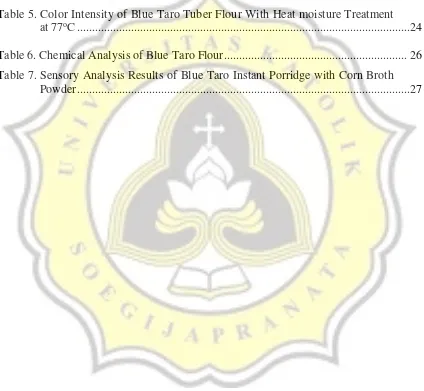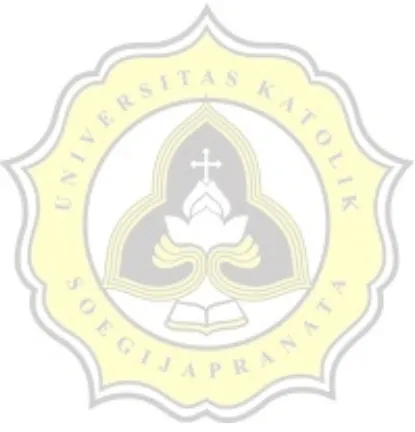DIVERSIFICATION OF BLUE TARO TUBER
(Xanthosoma sagittifolium L. Schott) PRODUCT THROUGH HEAT
MOISTURE TREATMENT TO PRODUCE INSTANT PORRIDGE
WITH CORN BROTH TASTE
DIVERSIFIKASI PRODUK UMBI KIMPUL
(Xanthosoma sagittifolium L. Schott) MELALUI PROSES HEAT
MOISTURE MENJADI BUBUR INSTAN DENGAN CITA RASA
KALDU JAGUNG
BACHELOR THESIS
Submitted to the Faculty of Agricultural Technology
in partial fulfillment of requirements for obtaining the bachelor degree
By :
YUNI RUSIANA
11.70.0055
DEPARTMENT OF FOOD TECHNOLOGY
FACULTY OF AGRICULTURAL TECHNOLOGY
SOEGIJAPRANATA CATHOLIC UNIVERSITY
SEMARANG
ii
STATEMENT OF THESIS AUTHENTICITY
The undersigned :
Name : Yuni Rusiana
Student number : 11.70.0055
Faculty : Agricultural Technology Department : Food Technology
Declares that Thesis entitled “DIVERSIFICATION OF BLUE TARO TUBER (Xanthosoma sagittifolium L. Schott) PRODUCT THROUGH HEAT MOISTURE TREATMENT TO PRODUCE INSTANT PORRIDGE WITH CORN BROTH TASTE”is truly my original work to fulfill the requirement for obtaining the bachelor degree in Soegijapranata Catholic University, Semarang. As long as I know, there is none work or opinion that had been written or published by another people, except those mentioned in references. If someday part or whole of this Thesis is proved and found as plagiarism, then I deserve to be canceled with any risk of its punishment as the regulation that applicable in Soegijapranata Catholic University and/or the applicable of legislation.
Semarang, March, 2015
Yuni Rusiana
iii
DIVERSIFICATION OF BLUE TARO TUBER
(Xanthosoma sagittifolium L. Schott) PRODUCT THROUGH HEAT
MOISTURE TREATMENT TO PRODUCE INSTANT PORRIDGE
WITH CORN BROTH TASTE
DIVERSIFIKASI PRODUK UMBI KIMPUL
(Xanthosoma sagittifolium L. Schott) MELALUI PROSES HEAT
MOISTURE MENJADI BUBUR INSTAN DENGAN CITA RASA
KALDU JAGUNG
By :
YUNI RUSIANA
NIM : 11.70.0055
Department : Food Technology
This bachelor thesis has been approved and defended
in front of examiners in March, 5th 2015
Semarang, March 2015
Agricultural Technology Faculty
Soegijapranata Catholic University
Supervisor, Dean,
Dr. Ir. Lindayani, MP. Dr. V. Kristina Ananingsih, ST. MSc.
Co-Supervisor,
iv SUMMARY
v
RINGKASAN
Pada umumnya, masyarakat Indonesia masih mengkonsumsi beras sebagai makanan pokok. Untuk mengurangi tingginya angka konsumsi beras, umbi-umbian seperti kimpul (Xanthosoma sagittifolium L. Schott) dapat diproses menjadi produk bubur instan sehingga dapat memenuhi kebutuhan karbohidrat sebagai pengganti beras. Umbi kimpul cenderung memiliki rasa yang tawar walaupun memiliki senyawa bioaktif seperti diosgenin dan polisakarida larut air dan kandungan nutrisi yang tinggi. Oleh sebab itu, bubur instan yang diproduksi menggunakan umbi kimpul akan dikombinasikan dengan bubuk kaldu jagung untuk memberikan citarasa dan aroma yang khas serta meningkatkan penerimaan konsumen. Namun, umbi kimpul memiliki granula pati yang sulit untuk mengalami rehidrasi. Teknik heat moisture dapat digunakan untuk memodifikasi pati umbi kimpul dan meningkatkan rehidrasinya. Tujuan dilakukannya penelitian ini adalah untuk menghasilkan bubur instan dengan penambahan bubuk kaldu jagung sebagai alternatif makanan pengganti beras, dan
untuk mengetahui pengaruh perlakuan heat moisture yang berbeda terhadap
vi
ACKNOWLEDGEMENT
Praise in the name of God because of His guidance, the author has finished the bachelor
thesis entitled “Diversification of Blue Taro Tuber (Xanthosoma sagittifolium L. Schott)
Product Through Heat Moisture Treatment to Produce Instant Porridge With Corn Broth
Taste.”There are so many new experiences, knowledges and motivation during author’s
study and finishing this thesis at Soegijapranata Catholic University. Hopefully, all of
these experiences and knowledges will be useful for author and all parties.
This thesis completed by assistance from some great people around the author as a
guider and supporter. Therefore, the writer would like to express the sincerest gratitude
to everyone who has helped in finishing this thesis :
1. Dr. V. Kristina Ananingsih, ST. MSc. as the dean of Faculty of Agricultural
Technology, Department of Food Technology Soegijapranata Catholic University.
2. Dr. Ir. Lindayani, MP. as supervisor who has generously spared her time to
support and supervise during finishing this thesis. The author really appreciates
the guidance and patience given to complete this thesis. Thank you for giving the
great inspiration.
3. Ir. Sumardi, MSc. as co-supervisor who has guided the author from the very
beginning of author’s study until finishing this thesis. Thank you for the time, patience, motivation and advices. Thank you for the great mentoring.
4. Author’s parents and families who always give the great support for the author,
especially author’s sisters Yani and Lyanti. Thank you for the love and encouragement.
5. Jonathan Alvin, Amanda Patricia and Nies Mayangsari as the author’s beloved
friends who always help and support during author’s study and research. Thank
vii
6. Shannon, Tabita, Amelia, Etha, Yosie, Aletheia, Dea, Hendra, George, Anggoro,
as the author’s laboratory partner who always help during the experiment. You are
the best guys.
7. For all the lectures at Food Technology Department who have guided and given
knowledge to the author.
8. Mas Soleh, Mas Pri, Mbak Endah, and Mas Lylyx as the laboratory assistant who
always help and give advice to the author during the experiment in the laboratory.
9. Thank you for all administration staff for always giving support and help the
author in completing the administration archives, and also all employees for
providing endless help for the author.
10. All related parties who helped the author finishing this thesis, which cannot be
possibly mentioned one by one.
Semarang, March, 2015
The Author,
viii
1.2. Literature Review ... 2
1.2.1. Blue Taro Tuber (Xanthosoma sagittifolium L. Schott) ... 2
1.2.2. Corn (Zea mays L.) ... 4
1.2.3. Instant Porridge ... 5
1.2.4. Heat Moisture Treatment ... 6
1.3. Objectives ... 8
2. MATERIALS AND METHODS ... 9
2.1. Place and Time ... 9
2.2. Materials ... 9
2.2.1. Equipments ... 9
2.2.2. Materials ... 9
2.3. Methods ... 10
2.3.1. Preliminary Study ... 10
2.3.1.1. Flouring Process of Blue Taro Tubers ... 10
2.3.2. Main Study ... 12
2.3.2.1. Heat Moisture Treatment ... 12
2.3.2.2. Corn Broth Powder... 13
2.3.2.3. Instant Porridge ... 14
2.3.3. Chemical Analysis of Blue Taro Tuber Flour ... 15
2.3.3.1. Moisture Content ... 15
2.3.3.2. Ash Content ... 16
2.3.3.3. Protein ... 16
2.3.3.4. Fat ... 17
2.3.3.5. Fiber Analysis ... 17
2.3.3.6. Carbohydrate Analysis ... 18
2.3.4. Physical Analysis of Heat Moisture Blue Taro Tuber Flour ... 18
2.3.4.1. Dispersibility ... 18
2.3.4.2. Color Measurement ... 18
2.3.4.3. Swelling Power Index Analysis ... 19
2.3.4.4. Solubility Analysis ... 19
2.3.4.5. Water Absorption Index Analysis ... 19
2.3.4.6. Bulk Density ... 20
ix
2.3.5. Analysis of Instant Porridge ... 20
2.3.5.1. Sensory Analysis ... 20
2.3.6. Data Analysis ... 20
3. RESULTS ... 22
3.1. Physical Analysis of Blue Taro Flour ... 22
3.2. Chemical Analysis of Blue Taro Flour ... 26
3.3. Sensory Analysis ... 27
4. DISCUSSION ... 29
4.1. Physical Analysis of Blue Taro Instant Porridge ... 29
4.1.1. Rehydration, Solubility, Water Absorption Index (Main Parameter) ... 29
4.1.2. Color ... 31
4.1.3. Bulk Density ... 31
4.1.4. Dispersibility ... 32
4.1.5. Swelling Power ... 32
4.2. Chemical Analysis of Blue Taro Flour as The Material of Instant Porridge ... 34
4.2.1. Moisture Content ... 34
4.2.2. Ash Content ... 34
4.2.3. Protein ... 35
4.2.4. Fat ... 36
4.2.5. Crude Fiber ... 37
4.2.6. Carbohydrate ... 38
4.3. Sensory Analysis of Blue Taro Instant Porridge ... 39
x
LIST OF TABLES
Table 1. Nutrient Content in 100 g of Blue Taro Tuber ... 3
Table 2. Nutrient Content of 100 g of Sweet Corn ... 5
Table 3. Physical Analysis Results of Blue Taro Tuber Flours With Heat moisture Treatment at 77oC ... 22
Table 4. Physical Analysis Results of Blue Taro Tuber Flours With Heat moisture Treatment at 110oC ... 23
Table 5. Color Intensity of Blue Taro Tuber Flour With Heat moisture Treatment at 77oC ... 24
Table 6. Chemical Analysis of Blue Taro Flour ... 26
xi
LIST OF FIGURES
Figure 1. Blue taro tuber (Personal Documentation) ... 3
Figure 2. Diagram of blue taro tuber flour processing ... 11
Figure 3. Diagram of heat moisture treatment ... 13
Figure 4. Diagram of corn broth powder processing ... 14
Figure 5. Diagram of instant porridge processing ... 15
Figure 6. The appearance of blue taro flour with different heat moisture treatment,(a) Blue taro flour without heat moisture treatment, (b) Heat moisture blue taro flour at 77oC (3 hours), (c) Heat moisture blue taro flour at 77oC (6 hours), (d) Heat moisture blue taro flour at 77oC (9 hours), (e) Heat moisture blue taro flour at 110oC (3 hours), (f) Heat moisture blue taro flour at 110oC (6 hours), (g) Heat moisture blue taro flour at 110oC (9 hours). ... 25
Figure 7. Panelist preferrences about blue taro instant porridge combined with corn broth powder ... 27
Figure 8. Blue taro instant porridge (1) Control, (2) Instant porridge under heat moisture treatment at 77oC (3 hours) (3) Instant porridge under heat moisture treatment at 110oC (6 hours). ... 28
Figure 9. Process of making blue taro flour (a) Fresh blue taro tubers, (b) Blanching, (c) Slicing of blue taro tubers, (d) Soaking in water, (e) Soaking in sodium metabisulfit, (f) Drying in dehumydifier, (g) Crushing dry blue taro tubers using blender, (h) Sieving blue taro flour, (i) Blue taro flour ... 51
Figure 10. Process of making heat moisture blue taro flour (a) Water adding to the blue taro flour (b), (c) Putting blue taro flour in trays and cover with plastic wrap, (d) Putting blue taro flour in refrigerator, (e) Covering the tray with alumunium foil, (e) Drying in oven, (f) Heat moisture blue taro flour ... 52
Figure 11. Process of making instant corn broth(a) Fresh corn, (b) Cooking for one hour, (c) Filtering, (d) Corn broth, (e) Drying in oven, (f) Dry corn broth, (g) Crushing with blender, (h) Instant corn broth ... 53
xii
xiii
LIST OF APPENDICES
Appendix 1. Process of Making Blue Taro Flour ... 51
Appendix 2. Process of Making Heat Moisture Blue Taro Flour ... 52
Appendix 3. Process of Making Corn Broth Powder ... 53
Appendix 4. Process of Making Blue Taro Instant Porridge With Addition of Corn Broth ... 54
Appendix 5. The Color Intensity of Blue Taro Flour with Different Heat Moisture Treatment ... 55
Appendix 6. Worksheet of Sensory Analysis ... 56
Appendix 7. Scoresheet of Sensory Analysis ... 57
Appendix 8. Physical Statistic Analysis Using SPSS ... 60
Appendix 9. Chemical Statistic Analysis Using SPSS ... 65

